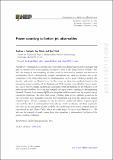Power counting to better jet observables
Author(s)
Larkoski, Andrew; Moult, Ian James; Neill, Duff Austin
DownloadLarkoski-2014-Power counting to be.pdf (3.438Mb)
PUBLISHER_CC
Publisher with Creative Commons License
Creative Commons Attribution
Terms of use
Metadata
Show full item recordAbstract
Optimized jet substructure observables for identifying boosted topologies will play an essential role in maximizing the physics reach of the Large Hadron Collider. Ideally, the design of discriminating variables would be informed by analytic calculations in perturbative QCD. Unfortunately, explicit calculations are often not feasible due to the complexity of the observables used for discrimination, and so many validation studies rely heavily, and solely, on Monte Carlo. In this paper we show how methods based on the parametric power counting of the dynamics of QCD, familiar from effective theory analyses, can be used to design, understand, and make robust predictions for the behavior of jet substructure variables. As a concrete example, we apply power counting for discriminating boosted Z bosons from massive QCD jets using observables formed from the n-point energy correlation functions. We show that power counting alone gives a definite prediction for the observable that optimally separates the background-rich from the signal-rich regions of phase space. Power counting can also be used to understand effects of phase space cuts and the effect of contamination from pile-up, which we discuss. As these arguments rely only on the parametric scaling of QCD, the predictions from power counting must be reproduced by any Monte Carlo, which we verify using Pythia 8 and Herwig++. We also use the example of quark versus gluon discrimination to demonstrate the limits of the power counting technique.
Date issued
2014-12Department
Massachusetts Institute of Technology. Center for Theoretical Physics; Massachusetts Institute of Technology. Department of Physics; Massachusetts Institute of Technology. Laboratory for Nuclear ScienceJournal
Journal of High Energy Physics
Publisher
Springer-Verlag
Citation
Larkoski, Andrew J., Ian Moult, and Duff Neill. “Power Counting to Better Jet Observables.” J. High Energ. Phys. 2014, no. 12 (December 2014).
Version: Final published version
ISSN
1029-8479
1126-6708